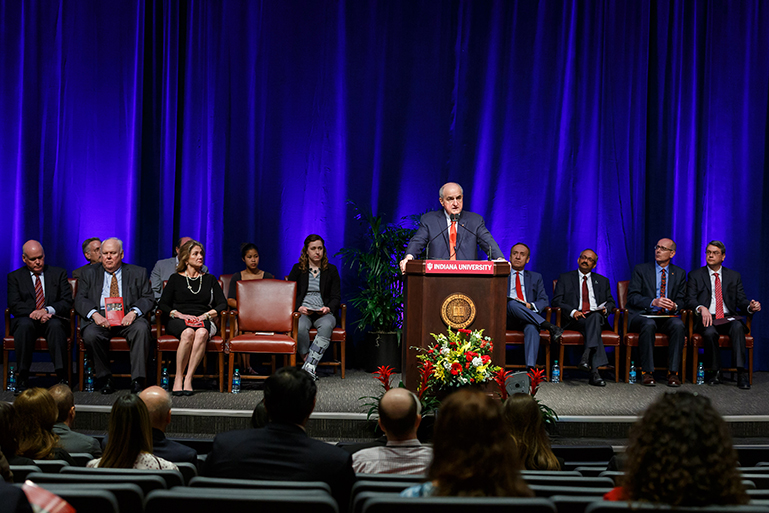Introduction
Charles Klauder, an architect who designed many university buildings around the country, including the magnificent and iconic Cathedral of Learning at the University of Pittsburgh, once wrote that colleges and universities are particularly well suited to reap the benefits of forethought and skill in planning.
"Nowhere is it more essential," he wrote, "to have the physical plant beautiful and well-knit together; nowhere should it be more feasible to enlist the careful thought of well-trained minds, to weigh and reconcile all component parts, to profit by the past, to measure accurately the present, (and) to forecast the future as well as it can be forecast…"1
Today, as we symbolically break ground for Innovation Hall, we note that Indiana University and the IUPUI campus truly have “enlisted the careful thought of well-trained minds” in order to profit by the past, to measure accurately the present, and to forecast—and make provisions for—the future.
Enlisting the careful thought of well-trained minds
Some years ago, over a period of many months, faculty, students, staff, administrators, and local community leaders—many of whom are here today—gave extensive input to the Master Plan for IUPUI, which was completed and approved in its final form by the IU Board of Trustees in 2012. During the planning process, considerable effort was made to maximize collaboration and inclusiveness. The resulting Master Plan was—and is—a superb blueprint for the future development of this campus.
One important area addressed by the Master Plan was the quality of teaching and research space on the campus. It called for the addition of future research and instruction space that facilitates interdisciplinary collaboration and interaction through group work and active learning, as well as physical integration of programs within buildings.
Innovation Hall will be just such a space, providing much-needed research and classroom space that will accommodate the growth of the three schools whose programs it will house.
Profiting by the past
In planning for this splendid new facility, we have also, fittingly, "profited by the past" of a campus that has, over the last 50 years, firmly established itself nationally as a thriving urban research campus.
The IUPUI Master Plan also recommended that future campus buildings be designed in a way that promotes architectural unity and establishes a sense of place.
Innovation Hall, whose exterior design will harmonize with existing campus landmarks including the Campus Center and the James J. Fritts D.D.S. Clinical Care Center, will strengthen the overall character of the campus.
And, as a "gateway" building, it will provide members of the university community and visitors with an even stronger and more visceral sense that they are entering a great urban research campus.
Providing for the future of STEM education
The new building also, of course, helps to provide for the future of education in the vitally important STEM disciplines—science, technology, engineering, and mathematics—fields that help increase the base of highly-skilled workers who meet state and national needs in a wide variety of industries.
A Pew Research Center analysis shows that employment in STEM occupations has increased by 79 percent since 1990, outpacing overall U.S. job growth.2 The advanced industry employers who dominate STEM hiring also are also leaders in research and development investment, exports, and their industries contribute enormously to the economies of their states and the nation. Because STEM workers are highly-paid, highly-productive, and tend to work for high-growth companies, each new STEM job created is estimated to create two more local jobs with broad economic impact.3
And, as a recent report from the Brookings Institution noted, cities that have successfully made the transition from manufacturing to advanced industry economies are often anchored by urban research campuses, like IUPUI, that help meet STEM workforce demands and drive innovation through applied research and industry partnerships.4
Conclusion
The renowned architect Robert A. M. Stern, who designed the Information and Communications Technology Complex, to which Innovation Hall will be adjacent, wrote that "Academic institutions define their own educational missions, and buildings give them shape. But," he continues, "campus buildings also have an obligation to context: each has to take its place in the ensemble, each must reflect the historic roots of learning and creativity, while embodying the evolving ideals of the academic community."5
All of us look forward with great anticipation to the day when Innovation Hall takes its place in the ensemble, and we look forward to witnessing the many ways the building will embody the evolving ideals of Indiana University and the IUPUI campus.
Thank you very much.
Source Notes
- Charles Z. Klauder and Charles C. Wise, College Architecture and its Part in the Development of the Campus, (C. Scribner’s Sons, 1929), p. 23.
- Nikki Graf, Richard Fry, Cary Funk, “Seven Facts About the Stem Workforce,” Pew Research Center, January 9, 2018, Web, Accessed April 19, 2019, URL: https://www.pewresearch.org/fact-tank/2018/01/09/7-facts-about-the-stem-workforce/.
- Alan Berube, Cecile Murray, “Renewing America’s Economic Promise Through Older Industrial Cities,” Brookings Institution, April 2018, Web, Accessed April 19, 2019.
- Ibid.
- Robert A.M. Stern, Robert A.M. Stern: On Campus: Architecture, Identity, and Community, (Monacelli Press, 2010), 9.


